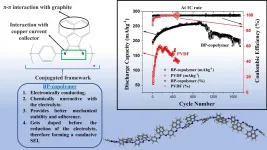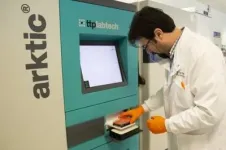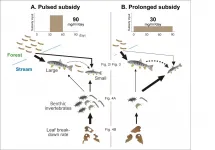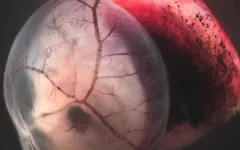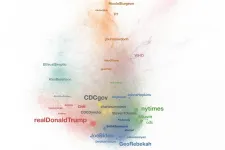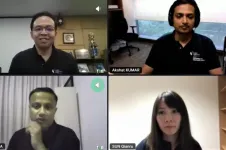Life's rich pattern: Researchers use sound to shape the future of printing
Researchers in the UK have developed a way to coax microscopic particles and droplets into precise patterns by harnessing the power of sound in air. The implications for printing, especially in the fields of medicine and electronics, are far-reaching.
2021-03-05
(Press-News.org) Researchers in the UK have developed a way to coax microscopic particles and droplets into precise patterns by harnessing the power of sound in air. The implications for printing, especially in the fields of medicine and electronics, are far-reaching.
The scientists from the Universities of Bath and Bristol have shown that it's possible to create precise, pre-determined patterns on surfaces from aerosol droplets or particles, using computer-controlled ultrasound. A paper describing the entirely new technique, called 'sonolithography', is published in Advanced Materials Technologies.
Professor Mike Fraser from the Department of Computer Science at the University of Bath, explained: "The power of ultrasound has already been shown to levitate small particles. We are excited to have hugely expanded the range of applications by patterning dense clouds of material in air at scale and being able to algorithmically control how the material settles into shapes."
The researchers believe their work could revolutionise printing, improving the speed, cost, and precision of non-contact patterning techniques in air. Their work already shows the potential of sonolithography for biofabrication.
Dr Jenna Shapiro, research associate in the School of Cellular and Molecular Medicine at the University of Bristol and lead author of the article, said: "Sonolithography enables gentle, non-contact and rapid patterning of cells and biomaterials on surfaces. Tissue engineering can use biofabrication methods to build defined structures of cells and materials. We are adding a new technique to the biofabrication toolbox."
Professor Bruce Drinkwater, professor of Ultrasonics in Bristol's Department of Mechanical Engineering, added: "The objects we are manipulating are the size of water drops in clouds. It's incredibly exciting to be able to move such small things with such fine control. This could allow us to direct aerosol sprays with unheard of precision, with applications such as drug delivery or wound healing."
Beyond its applications in biomedicine, the team has shown the technique to be applicable to a variety of materials. Printed electronics is another area the team is keen to develop, with sonolithography being used to arrange conductive inks into circuits and components.
INFORMATION:
[Attachments] See images for this press release:

ELSE PRESS RELEASES FROM THIS DATE:
2021-03-05
Anyone who has owned a smartphone for over a year is most likely aware that its built-in lithium (Li)-ion battery does not hold as much charge as when the device was new. The degradation of Li-ion batteries is a serious issue that greatly limits the useful life of portable electronic devices, indirectly causing huge amounts of pollution and economic losses. In addition to this, the fact that Li-ion batteries are not very durable is a massive roadblock for the market of electric vehicles and renewable energy harvesting. Considering the severity of these issues, it is no surprise that researchers have been actively ...
2021-03-05
In recent years, researchers have begun using functional magnetic resonance imaging (fMRI) not just for better understanding the neural bases of psychiatric illness, but also for experimental treatment of depression, ADHD, anxiety, PTSD, substance use disorder, and schizophrenia with a technique called real-time fMRI neurofeedback.
While rtfMRI-NF has emerged in recent years as a promising experimental intervention, it's also a costly procedure that requires extensive technical setup to allow for real-time analysis. That's why a quantitative data review was overdue.
A team of END ...
2021-03-05
In the brain, billions of neurons reach to each other, exchanging information, storing memories, reacting to danger and more. Scientists have barely scratched the surface of the most complex organ, but a new device to automatically collect tissue for analysis may allow for a quicker, deeper dive into the brain.
Their approach was published in IEEE/CAA Journal of Automatica Sinica, a joint publication of the IEEE and the Chinese Association of Automation.
"The ultimate goal of this study is to further promote the speed and quality of 3D-reconstruction of brain neural connections," said the author Long ...
2021-03-05
Insects that fall from the surrounding forest provide seasonal food for fish in streams. Researchers at Kobe University and The University of Tokyo have shown that the lengthening of this period has a profound effect on food webs and ecosystem functions present in streams.
These research results provide proof that changes in forest seasonality also affect the ecosystems of nearby rivers. This finding highlights the importance of predicting the effects of climate change on ecosystems.
The research group consisted of Associate Professor SATO Takuya and post-graduate student UEDA Rui of Kobe University's Graduate ...
2021-03-05
In a new study by the Yale Department of Immunobiology and Yale Cancer Center, researchers report combined liver and growth factor humanization enhances human red blood cell production and survival in circulation the immunodeficient murine host. The discovery could help in the development of treatments of life-threatening blood disorders, such as myelodysplastic syndrome, and diseases afflicting red blood cells, including sickle cell disease and malaria. The study is published online today in the journal Science.
"Red blood cell diseases, such as thalassemia and sickle cell disease involve approximately 5% of ...
2021-03-05
Professor Byoungwoo Kang develops a high-density cathode material through controlling local structures of the Li-rich layered materials.
Researchers in Korea have developed a high-capacity cathode material that can be stably charged and discharged for hundreds of cycles without using the expensive cobalt (Co) metal. The day is fast approaching when electric vehicles can drive long distances with Li- ion batteries.
Professor Byoungwoo Kang and Dr. Junghwa Lee of POSTECH's Department of Materials Science and Engineering have successfully developed a high energy-density cathode material that can stably maintain charge and discharge for over 500 cycles without the expensive ...
2021-03-05
Most people have heard of stem cells, cells from which all other cells with specialized functions are generated. Hematopoietic stem cells (HSCs) are the architects of blood cell development and are responsible for blood cell formation throughout the life of an organism. HSCs are also used in the treatment of cancer and immune disturbances.
Previous research into HSC transplantation has involved the use of adult and fetal mice. This has involved the removal of recipient HSCs using approaches including irradiation and the administration of DNA damaging drugs. In a first of its kind, researchers from the University of Tsukuba devised a novel approach for HSC deletion in mouse embryos. This report provides the first description of embryonic HSC depletion and transplantation of donor HSCs ...
2021-03-05
SMU Office of Research and Tech Transfer - One of the motivations for the recently published Journal of Accounting Research paper "Politically Connected Governments" was the daily experience with the subway system in New York City.
The author of the paper, SMU Assistant Professor of Accounting Kim Jungbae, told the Office of Research & Tech Transferthe research question for the paper which examines the consequences of powerful political connections for local governments, was inspired by the New York Times article "The Most Expensive Mile of Subway Track on Earth" (January 24, 2018).
"The article suggests that the NYC subway system is ...
2021-03-05
Since the start of the Covid-19 pandemic, charts and graphs have helped communicate information about infection rates, deaths, and vaccinations. In some cases, such visualizations can encourage behaviors that reduce virus transmission, like wearing a mask. Indeed, the pandemic has been hailed as the breakthrough moment for data visualization.
But new findings suggest a more complex picture. A study from MIT shows how coronavirus skeptics have marshalled data visualizations online to argue against public health orthodoxy about the benefits of mask mandates. Such "counter-visualizations" are often quite sophisticated, using datasets from official sources and state-of-the-art visualization ...
2021-03-05
SMU Office of Research & Tech Transfer - Even before countries began rolling out their vaccination campaigns, Pfizer, Moderna and AstraZeneca's announcements had already proved fortifying shots. Stocks rallied and healthcare workers celebrated in the wake of the vaccine news late last year. But months on, that early euphoria has somewhat evaporated, replaced by uncertainty and debate over vaccine safety, possible side effects and varying degrees of citizen reluctance.
Artificial intelligence (AI) researchers and health experts modelling COVID-19's spread ...
LAST 30 PRESS RELEASES:
[Press-News.org] Life's rich pattern: Researchers use sound to shape the future of printing
Researchers in the UK have developed a way to coax microscopic particles and droplets into precise patterns by harnessing the power of sound in air. The implications for printing, especially in the fields of medicine and electronics, are far-reaching.

